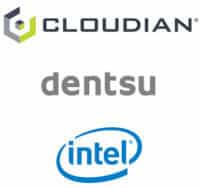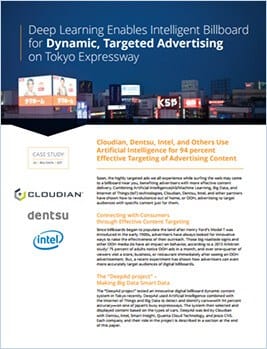Deep Learning Enables Intelligent Billboard for Dynamic, Targeted Advertising on Tokyo Expressway
Soon, the highly targeted ads we all experience while surfing the web may come to a billboard near you, benefiting advertisers with more effective content delivery. Combining Artificial Intelligence (AI) / Machine Learning, Big Data, and Internet of Things (IoT) technologies, Cloudian, Dentsu, Intel, and other partners have shown how to revolutionize out of home, or OOH, advertising to target audiences with specific content just for them.
Connecting with Consumers through Effective Content Targeting
Since billboards began to populate the land after Henry Ford’s Model T was introduced in the early 1900s, advertisers have always looked for innovative ways to raise the effectiveness of their outreach. Those big roadside signs and other OOH media do have an impact on behavior, according to a 2013 Arbitron study.1 75 percent of adults notice OOH ads in a month, and over one-quarter of viewers visit a store, business, or restaurant immediately after seeing an OOH advertisement. But, a recent experiment has shown how advertisers can even more accurately target audiences of digital billboards.
The “DeepAd project” – Making Big Data Smart Data
The “DeepAd project” tested an innovative digital billboard dynamic content system in Tokyo recently. DeepAd used Artificial Intelligence combined with the Internet of Things and Big Data to detect and identify cars—with 94 percent accuracy—on one of Japan’s busy expressways. The system then selected and displayed content based on the types of cars. DeepAd was led by Cloudian with Dentsu, Intel, Smart Insight, Quanta Cloud Technology, and Jesco CNS. Each company and their role in the project is described in a section at the end of this paper.

DeepAd Architecture The “DeepAd Project” used recognition, identification, and control through Machine Learning and Deep Learning to turn Big Data into Smart Data, delivering instant value that can lead to real time benefits for OOH advertising and other use cases,” said Michael Tso, CEO and co-founder of Cloudian.
Smart Architecture for Smart Content
The “DeepAd Project” acquired images of passing cars using a video camera mounted on a digital billboard. As cars approached, about 350 meters away in front of the camera an Intel® NUC Mini PC mounted near the camera provided zooming controls to the camera, while simultaneously sending video data over a highspeed network to the Detection System located in the Cloudian data center several miles from the billboard site.
The Detection System clarified the signal, removing vibration at the camera, and detecting overlapping vehicles and motion, and sent tracking controls back to the Intel NUC for the period of recognition. The video camera and Intel NUC continued to watch the tracked automobile, while sending data to the Recognition System, which determined the make, model, and year of the car. The Recognition System then told the Intel NUC which billboard content to display for the recognized car.

DeepAd Execution Flow
This all took place in about one-half of a second from the time the camera detected the car to the content selection. The content was displayed for about ten seconds. The system was trained to recognize specific car models, which were classified in three different categories for the purpose of delivering targeted messages:
- Luxury cars—including all models of Mercedes, BMW, Audi, and Lexus
- Family cars—Toyota Prius*, Aqua*, and Vitz,* plus Honda Fit*
- Project member cars—2001 Honda Odyssey*, 2010 Subaru Outback* BR9, and a 2001 Toyota Bb*
These cars, driven by members of the DeepAd Project passed by the camera several times. Until a car triggered the system, the digital billboard displayed current weather data (a). When a luxury car was detected, the content promoted golfing at a resort (b). The system presented family car drivers with content about a popular amusement park (c). Project members received a unique graphic image (d).
Leveraging Deep Learning for Real-Time Decisions
To accurately recognize cars with 94 percent accuracy, the Deep Learning environment was fed as many as 5,000 images of each targeted car type to train the algorithm on the automobiles the system was to target. There was nothing special about the images; they were acquired publicly from automobile manufacturers’ and dealerships’ websites. The algorithm looked at key features of each car, such as fender radii (corner angle), headlights, and other characteristics, to determine the automobile maker, model, and year.
Cloudian developed the algorithms and other application code. The execution environment was run on Quanta Cloud Technology servers, while all data was stored on Cloudian’s HyperStore* servers. The execution environment was hosted in Cloudian’s data center in Tokyo. “Multi-core Intel® Xeon® Processor E5 family and the high performance of the servers due to their design and code running on Intel® architecture were critical to enabling the speed at which real-time detection, control, and decision making were possible,” stated Ron Kasabian, Vice President of Big Data Analytics at Intel. “Having the small size with the advanced performance of the Intel NUC kept the technology footprint small in the field while delivering the speed needed to help accurately detect and track cars,” he added.
“For everything to happen within one-half of a second was imperative, considering the speed at which drivers passed before the advertising zone,” commented Mr. Tso. “This experiment, supported by technology leaders, illustrates how a combination of advancing technologies can enable more effective targeting for OOH in real-time while tracking moving automobiles on a busy expressway,” said Mr. Jinnai. The companies are continuing the experiment, with testing in a major shopping mall’s parking center in Tokyo. “By detecting automobiles as shoppers enter the parking garage, we can target buyers with current sales and other purchasing opportunities within the mall,” added Mr. Jinnai.
Beyond Advertising – Machine Learning for Public and Business Use Cases
“This is an unprecedented application of Deep Learning, IoT technology, and Big Data that can have an impact on a much larger scale beyond commercial applications,” said Mr. Tso. “Such an architecture will be valuable to government and business in automated monitoring and security of roadways, enterprise campuses, and other venues, among other use cases.” Some potential applications for an architecture used in the DeepAd project include the following:
- Real-time measurements of traffic flow using AI-based counting; no need for manual counting
- Roadway load monitoring by measuring large vehicles and regular cars on inbound and outbound lanes
- Searching and tracking of license plates, such as for Amber Alerts (in the U.S.)
- Safety monitoring to trigger roadway and parking lot warnings, such as water covered roads, falling objects, broken-down cars, illegal parking, etc.
Such applications could leverage existing cameras already in the roadways’ system to reduce costs of AI-based monitoring.
DeepAd Project Technology Partners
The companies contributing to the DeepAd experiment included:
Cloudian (cloudian.com), a leading provider of object storage technologies for on-premise and hybrid cloud storage. Cloudian developed the application code and hosted the storage and execution environment.
Dentsu (www.dentsu.com), Japan’s largest advertising agency, developed the content and determined the audience targeting • Intel (www.intel.com), one of the world’s largest, innovative technology developers and manufacturers. Intel® architecture-based servers and storage technologies powered the experiment.
Smart Insight (smartinsight.jp), offering application software aiming to make effective use of expanded and diversified information is expected to provide a post-processing tool(s) at a future stage of the project.
Quanta Cloud Technology (QCT) (www.qct.io), a global data center solution provider offering hyperscale hardware with infrastructure software that serves cloud service providers, telecoms, and enterprises. QCT servers were the foundation of the execution computing environment.
Jesco CNS (www.jesco.co.jp/cns/), a leading facilities design and construction provider in Japan. Jesco CNS provided the billboard and facility services.
For more information on the DeepAd project and how these technologies can benefit your operations, contact Cloudian at cloudian.com/company/contact_us/




